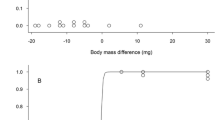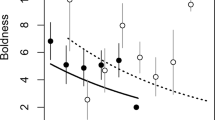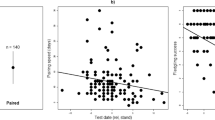Abstract
We used adults of the butterfly Eumaeus toxea for two purposes—description of male territorial behavior and investigation of whether body size and muscle fat reserves correlated with social status (resident or intruder) and the probability of winning a territorial contest in dyadic encounters. Males perched in places near cycads (Zamia furfuracea), where females lay eggs. Resident males (those with faithfulness to the same site for several days) used two types of flight of different duration, short (ca. 5 s) and long (ca. 17 s), against male conspecifics. Because of this difference the latter were regarded as true contests. Males that copulated were residents and were also larger than males not observed in copulation. Residents and winners of contests were larger and fatter than intruders (males entering the site that faced a resident with a long-lasting flight) and losers of contests, respectively, possibly because these last two categories of male were individuals with already exhausted energy stores. Body size and fat reserves seemed to correlate with status for resident and intruder males but not for winner and loser males. This possibly means that body size reflects male energy condition. This is supported by the fact that large, resident males are confronted in short contests, in contrast with small, resident males. Our study suggests that the role of size and fat reserves during contests cannot be discounted in butterflies.




Similar content being viewed by others
References
Andersson M (1994) Sexual selection. Princeton University Press, Princeton
Anholt BR, Marden JH, Jenkins DM (1991) Patterns of mass gain in adult odonates. Can J Zool 69:1156–1163
Cordero C, Soberón J (1990) Non-resource based territoriality in males of the butterfly Xamia xamia (Lepidoptera: Lycaenidae). J Insect Behav 3:719–732
Darwin C (1871) The descent of man, and selection in relation to sex. Murray, London
Karlsson B (1994) Feeding habits and change of body composition with age in three nymphalid butterfly species. Oikos 69:224–230
Kemp DJ (2000) Contest behavior in the speckled wood butterfly: does size matter? Behav Ecol 11:591–596
Kemp DJ (2002) Butterfly contests and flight physiology: why do older males fight harder? Behav Ecol 13:456–461
Kemp DJ, Wiklund C (2001) Fighting without weaponry: a review of male–male contest competition in butterflies. Behav Ecol Sociobiol 49:429–442
Kemp DJ, Alcock J (2003) Lifetime resource utilization, flight physiology, and the evolution of contest competition in territorial insects. Am Nat 162:290–301
Kemp DJ, Wiklund C (2004) Residency effects in animal contests. Proc R Soc Lond ser B 271:1707–1711
Kemp DJ, Wiklund C, Van Dyck H (2006) Contest behaviour in the speckled wood butterfly (Pararge argeria): seasonal phenotypic plasticity and the functional significance of flight performance. Behav Ecol Sociobiol 59:403–411
Marden JH (2000) Variability in the size, composition and function of insect flight muscles. Ann Rev Physiol 62:157–178
Marden JH, Waage JK (1990) Escalated damselfly territorial contests are energetic wars of attrition. Anim Behav 39:954–959
Moore AJ (1990) The evolution of sexual dimorphism by sexual selection: the separate effects of intrasexual selection and intersexual selection. Evolution 44:315–331
Otronen M (1988) The effect of body size on the outcome of fights in burying beetles (Nicrophorus). Ann Zool Fenn 25:191–201
Plaistow JS, Siva-Jothy MT (1996) Energetic constrains and male mate-securing tactics in the damselfly Calopteryx splendens xanthostoma (Charpenter). Proc R Soc Lond Ser B 263:1233–1239
Rosenberg RH, Enquist M (1991) Contest behavior in Weidermeyer’s admiral butterfly Limenitis weidemeyerii (Nymphalidae): the effects of size and residency. Anim Behav 42:805–811
Schneider D, Wink M, Sporer F, Lounibos P (2002) Cycads: their evolution, toxins, herbivores and insect pollinators. Naturwissenschaften 89:281–294
Solares Leal I, Romo Beltrán AN (2001) Ciclo biológico de Eumaeus toxea Godart. (Lepidoptera: Lycaenidae) sobre Zamia furfuracea L. (Zamiaceae). Bachelor thesis. Universidad de las Américas-Puebla, Mexico
Stutt AD, Willmer P (1998) Territorial defence in speckled wood butterflies: do the hottest males always win? Anim Behav 55:1341–1347
Takeuchi T (2006) The effect of morphology and physiology on butterfly territoriality. Behaviour 143:393–403
Acknowledgments
To one anonymous reviewer and K. Ueda for their splendid suggestions, to Iván Sánchez-Barrera for his help in the field, and to Allari Romo Beltrán and Iliana Solares Leal for sharing some data on male fighting duration.
Author information
Authors and Affiliations
Corresponding author
About this article
Cite this article
Martínez-Lendech, N., Córdoba-Aguilar, A. & Serrano-Meneses, M.A. Body size and fat reserves as possible predictors of male territorial status and contest outcome in the butterfly Eumaeus toxea Godart (Lepidoptera: Lycaenidae). J Ethol 25, 195–199 (2007). https://doi.org/10.1007/s10164-007-0040-5
Received:
Accepted:
Published:
Issue Date:
DOI: https://doi.org/10.1007/s10164-007-0040-5




